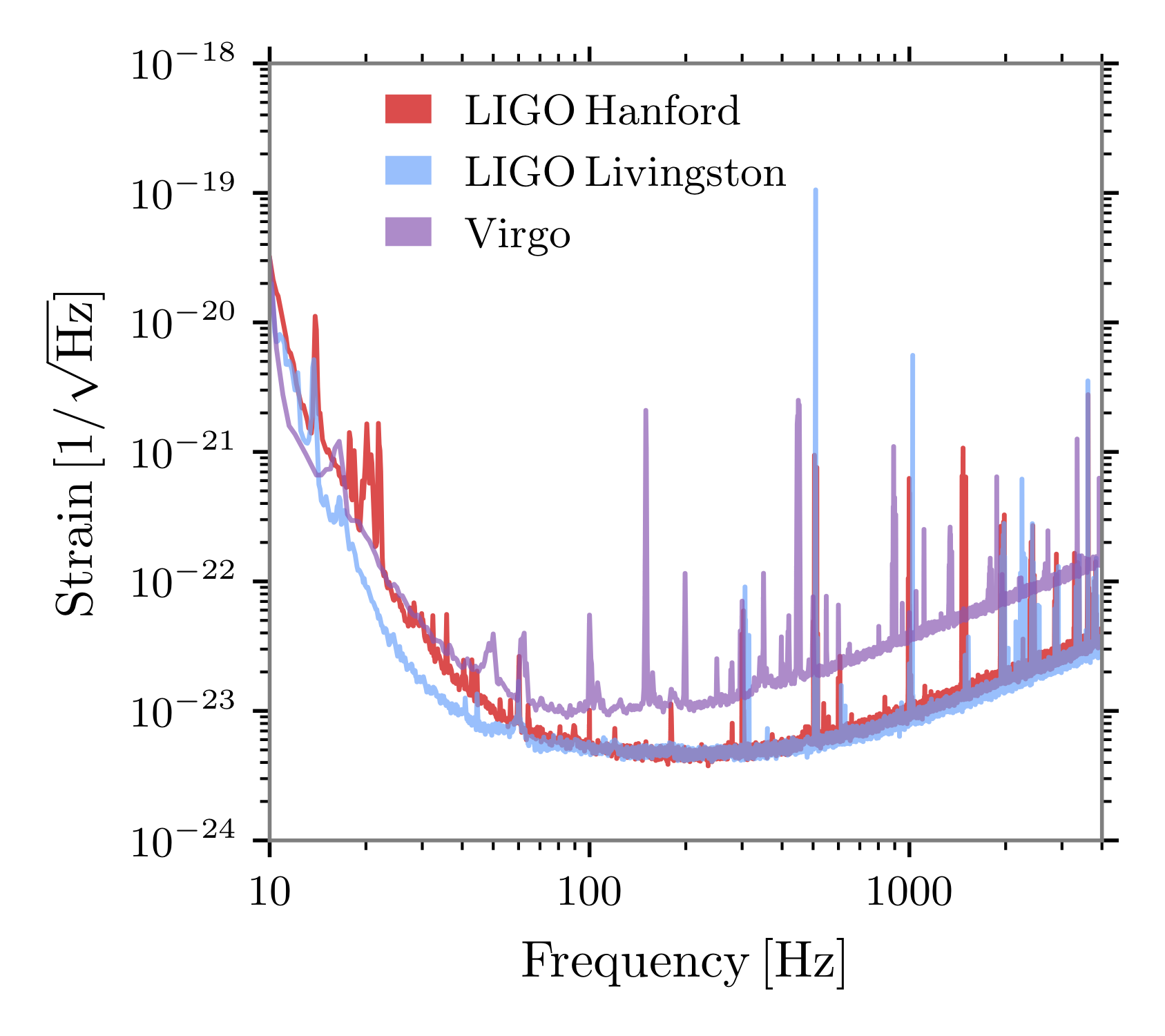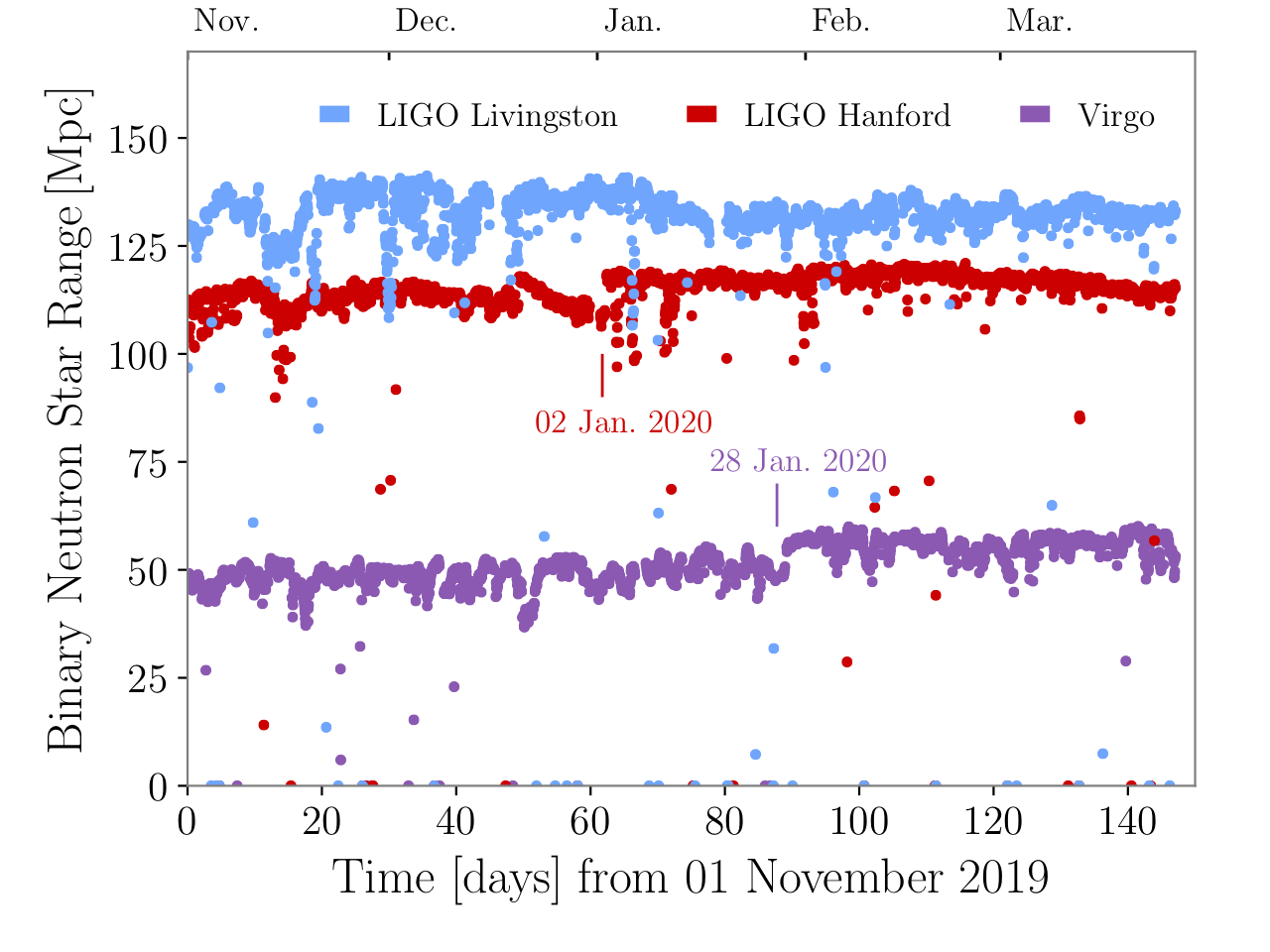The O3b Data Release
Run Overview
- The third LIGO/Virgo observation run (O3), is divided in two parts, O3a and O3b
- O3b dates: 1st November 2019 15:00 UTC (GPS 1256655618) to 27th March 2020 17:00 UTC (GPS 1269363618)
- This documentation refers to the data available from three detectors: H1, L1, and V1.
- Data are available at the original 16 KHz and the downsampled 4KHz sample rates.
- In addition to the final version of the strain data, a few additional versions are also available.
Get O3b Data
- Strain Data: 4 kHz Data 16 kHz Data
- Md5 checksums for 4KHz data: All 4KHz HDF5 files | All 4KHz GWF files
- Md5 checksums for 16KHz data: All 16KHz HDF5 files | All 16KHz GWF files
- Segments: Timeline Data Quality
- Detections, analysis results and further information: GWTC-3
- Cluster Access: CernVM-FS
GWF Channel Names
The final version of the strain data, available using the buttons above, is sourced from the channels:
H1:DCS-CALIB_STRAIN_CLEAN-SUB60HZ_C01L1:DCS-CALIB_STRAIN_CLEAN-SUB60HZ_C01V1:Hrec_hoft_16384Hz
See the technical details page for the channel names used in the O3b 4 kHz and 16 kHz GWF files (ending with extension .gwf).
Alternate Calibration Release
In addition to the final version of the strain data, several additional versions are also available, including different calibration versions and/or cleaning methods.
- See Alternate Calibration Release for how to access these channels.
O3b Detector Performance
Astrophysical Results
Papers including results from O3b can be found following the links below:
- GWTC-3 Catalog paper
- GWTC-3 Data Release Documentation
- The population of merging compact binaries inferred using gravitational waves through GWTC-3
- Constraints on the cosmic expansion history from the third LIGO-Virgo-KAGRA Gravitational-Wave Transient Catalog
- LIGO/Virgo Detection Papers
- LIGO/Virgo Collaboration Publications Page
- Folded Data for Stochastic Searches
Data Quality Segments
Download Segments
- The DATA segment list indicates times when data are publicly available.
- See the Timeline Query Page for other O3b segment lists.
Segments Documentation
- The O2/O3 LIGO detector characterization paper and O3 Virgo detector characterization paper describe data quality categories
- Technical documents that list DQ flag names: document for LIGO and document for Virgo
- See also the technical details page
Hardware Injections
The O3b data set contains simulated astrophysical signals, known as hardware injections, used for testing and calibration. For an example, see the Find a Hardware Injection Tutorial (in the tutorial use the flags for the O3b run described here). For complete documentation, see:
Instrumental Spectral Lines
A power spectral density of LIGO data typically shows a number of spectral lines. Many of these are associated with known instrumental resonances. The O3 instrumental spectral lines page gives an explanation, and catalog, of these instrumental lines.
Representative PSDs


- The above plots are reproduced from Figures 2 and 3 of the GWTC-3 paper
- Plots of daily sensitivity are available on the archived detector status pages
Technical Details
GWOSC 4 kHz strain data have been repackaged and downsampled from 16384 Hz to 4096 Hz. Advanced LIGO and advanced Virgo data are not calibrated or valid below 10 Hz or above 5 kHz, and the data sampled at 4096 Hz are not valid above about 1700 Hz. In most searches for astrophysical sources, data below 20 Hz are not used because the noise is too high. More detailed information about the data set can be seen on the Technical Details page.
Acknowledge
To acknowledge the use of O3b data, see the Acknowledgement Page.
Data Set DOI: https://doi.org/10.7935/pr1e-j706
Revision History
- Nov 7, 2021: First release
- Nov 8, 2021: Updates to links in the Astrophysical Results section
- June 29, 2022: Added links to the Segments Documentation section
- August 30, 2022: Added links to MD5 checksums for strain data
